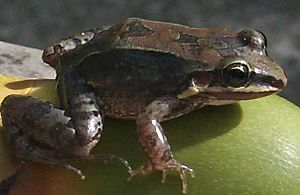Leptodactylus albilabris facts for kids
Quick facts for kids Leptodactylus albilabris |
|
|---|---|
 |
|
| Conservation status | |
| Scientific classification | |
| Synonyms | |
|
Cystignathus albilabris Günther, 1859 |
The Leptodactylus albilabris is a type of frog that belongs to the Leptodactylidae family. People often call it the white-lipped froglet or Hispaniolan ditch frog. You can find this frog in places like Hispaniola, Puerto Rico, and the British Virgin Islands and U.S. Virgin Islands.
Contents
About the White-Lipped Frog
This frog lives on the ground, which means it is a terrestrial animal. It has smooth skin, unlike some frogs that have bumpy skin like toads. The white-lipped frog starts its life as a tadpole.
What They Look Like
Young white-lipped frogs, or tadpoles, are brown. They can grow to be about 1.5 inches (13 millimeters) long.
Adult frogs have some special features. They have a white upper lip, which is how they got their name, albilabris. Their fingers and toes do not have webs between them. You might also see a black line between their eyes and the tip of their nose, and another line from their eye to their shoulder.
Most adult frogs are about 1.4 inches (3.5 centimeters) long from their snout to their rear. However, in higher places like the El Yunque National Forest in Puerto Rico, some frogs can grow bigger, even over 2.0 inches (5.0 centimeters).
Their skin is usually grayish-brown. They have stripes and bands on their back that can be different shades of brown, cream, or reddish-brown. Their belly is white. Some male frogs have dark spots on their throat. When they call out, they make a "pink-pink-pink" sound, often heard from muddy areas.
Life and Habits
The white-lipped frog eats different small creatures. Their diet includes insects, millipedes, and land snails.
Reproduction and Life Cycle
These frogs lay their eggs on the ground. They build a special foamy nest, usually hidden under a rock or a log. The eggs develop into tadpoles inside this foam nest.
When it rains, the tadpoles are washed out of their nest. They then finish growing in temporary pools of water or in slow-moving water.
Where They Live
You can usually find the white-lipped frog in muddy spots. They like areas near streams, marshes, and ditches.
See also
 In Spanish: Leptodactylus albilabris para niños
In Spanish: Leptodactylus albilabris para niños
Images for kids



